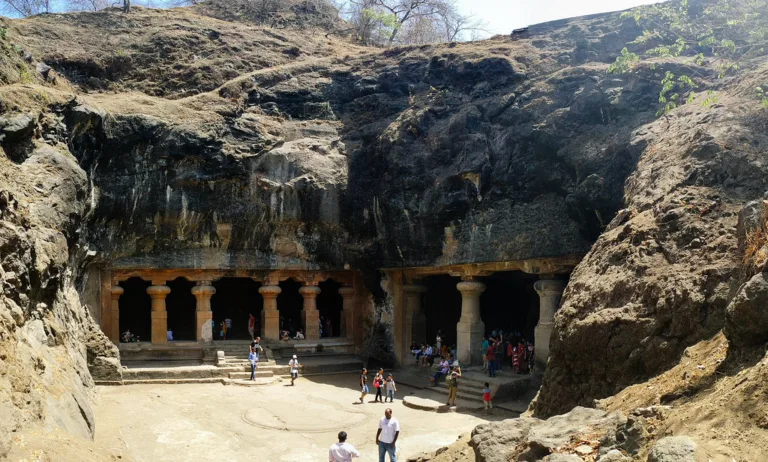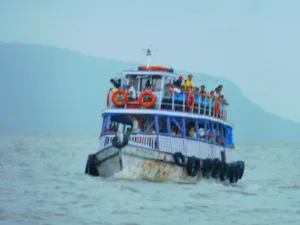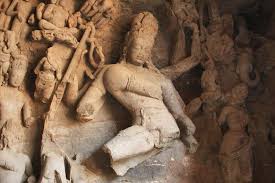Get ready to embark on a journey to a place where history meets with art – the Elephanta Caves. Nestled on Elephanta Island, just a hop away from bustling Mumbai, these caves are like a time capsule that decided to throw in a few surprises. So, grab some snacks, water, good grip shoes, Cap and let’s explore this archaeological wonderland on an island at the Arabian Sea.

The Arrival at Elephanta Caves: A "Boat-iful" Beginning
First things first, reaching Elephanta Caves is half the adventure. Hop on a ferry from the Gateway of India, and you’ll suddenly feel like you’re in a Bollywood movie – the sea breeze in your hair, the boat rocking to the rhythm of the waves. It’s like a rollercoaster over the sea with some seagulls chasing you for your snacks & setting up an amazing mood during your journey.

Elephanta Caves Island: The Monkey Business
As you land on the soil of Elephanta Island, you’ll be greeted by a gang of mischievous monkeys. They’re like the island’s welcome committee, and they take their job very seriously. Keep an eye on your snacks, or you might find a monkey impersonating a snack thief. So avoid eating in front of them please.
The Caves: Rock Stars of History
These ancient Elephanta Caves are the UNESCO World Heritage Site, a treasure chest of ancient Indian art and mythology. Imagine the cave walls as the original comic strips, narrating stories from the Hindu mythology Era.
These are believed to have originated from several Hindu kingdoms and date to the fifth through ninth century. Most often, they are dated to the fifth and seventh centuries. Many academics believe they were finished around 550 CE or so.
Trimurti: Shiva's Three-Faced stone craved marvel
The most significant sculpture in the elephanta caves is the three-faced Lord Shiva known as the Trimurti, which is regarded as a masterpiece. Shiva is essentially saying, “Why settle for just one expression when you can have three?” He is shown in relief on the south wall of the cave, facing the north entrance, along the north-south axis, with the faces of the Creator, Preserver, and Destroyer. It also goes by the names Maheshmurti and Sadashiva. The sculpture, which stands 5.45 m (17.9 ft) tall, features Panchamukha Shiva, a three-headed version of Shiva in the Elephanta Caves.

Shiva - The Lord of Dance (Nataraja)
Amidst all the serious mythology, you’ll find unexpected moments of humour at Elephanta caves. There’s a sculpture of Shiva as the Lord of the Dancer (Nataraja), and if you look closely, you’ll notice that it is in the Lalita mudra, his arms and body are depicted as violently swaying, representing occupying all of space, soaring energy, and complete weightlessness.

The Tatpurusha, Shiva’s manifested form that protects and upholds all of creation and creative activity. Nataraja is seen here with eight arms. He appears to be holding an axe, with a coiled serpent wrapped around the top, according to the panel’s fragments that have remained. In another, he is holding a folded cloth that may be a representation of the Maya veil.
The Elephant in the Room
Now, you might wonder about the name “Elephanta.” Turns out, it’s a bit of a mystery. Some say it’s because there used to be a giant elephant statue on the island (it’s since moved to a museum). Others think the Portuguese mistook the sculptures for elephants. Either way, it adds a touch of whimsy to your visit. But the Elephant statue storey is for real & the same has been now preserved at the Mumbai Byculla Zoo (Watch this video of the Mumbai Byculla Zoo).
Complete Tour Video Guide of Elephanta Caves on How to reach Elephanta Caves, Exploring Caves, Old Portuguese Canon on the Hill Top, Food & many more.
Practical Tips for this amazing Cave Adventure
If you’re planning a visit to Elephanta Caves, here are some tips:
- Wear comfy shoes – you’ll be doing a bit of rock-hopping.
- Stay hydrated – Carry enough water to be dehydrated during this touring.
- Monkey-proof your snacks – they’re experts to snatch your food so be careful while having your snack or food.
- Carry a Cap or a Hat since it’s very hot during summer.
How to reach here :
- After arriving in Mumbai, go to the Gateway of India. This is Mumbai’s most famous landmark.
- You can reach Gateway of India from Churchgate Railway Station or Chhatrapati Shivaji Maharaj Terminus Railway Station or can ride up to Gateway of India by your own car or Taxi.
- You can buy boat tickets for Elephanta Caves which is just in the front of Gateway of India.
- The ferry boat to Elephanta Caves Island will take around 60 minutes to reach.
- A little toy train runs for 5 rupees one way from the jetty to the foot of the hill. You could decide to stroll along the pier. This will take you to the Gharapuri village’s entrance. A security gate and a Rs. 5 admission fee are required for the village.
- To reach the plateau where the elephant caves are, you have to climb 120 stairs. This hiking route passes numerous kiosks offering souvenirs, gifts, mementoes, guidebooks, and T-shirts. At the end of this walk is the ticket booth for the caves.
Conclusion
The Elephanta Caves are like a masterpiece art gallery show set all over the stone, the amazing ancient mythology art and marvel at the artistry, and leave with a heart full of surprise and a camera full of memories. So, if you’re up for a dose of history with a side of humour, make a date with the Elephanta Caves – it’s an archaeological adventure like no other!

Also, read some of our fascinating Post :
- Juhu Chowpatty – Discovering the Magic of this beach where Mumbai Embraces the Sea.
- Chhatrapati Shivaji Maharaj Museum in Mumbai: Preserving History and Culture.
- Unveiling the Beauty of Maharashtra Nature Park: A Nature Lover’s Paradise.
- Explore the Beauty of Khandala Picnic Spot: A Perfect Getaway Near Mumbai.
- Bandra Fort & Sion Fort: The Iconic & Historic Defense Forts of Mumbai. A must-see place if you are in Mumbai.
- The Global Vipassana Pagoda: A Serene Oasis of Mindfulness.
- Penguin Paradise: Discover Byculla Zoo, India’s Exclusive Penguin World.
- Gorai Beach: A Serene Coastal Retreat near Mumbai.
- Mumbai Darshan Bus: Exploring the Vibrant City in Comfort and Style.
- Bandra, Mumbai: A Vibrant Suburb with a Rich Cultural Heritage.
#indiansites
frequently asked question
What is special about Elephanta Caves?
